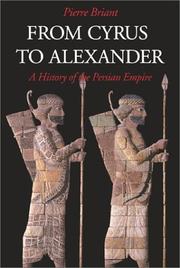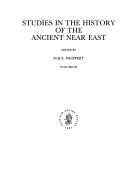| Listing 1 - 6 of 6 |
Sort by
|
Book
ISBN: 2850210927 2850210951 9782850210952 Year: 1996 Publisher: Paris Gabalda
Abstract | Keywords | Export | Availability | Bookmark
 Loading...
Loading...Choose an application
- Reference Manager
- EndNote
- RefWorks (Direct export to RefWorks)
Phönizien --- Beziehungen. Phönizier --- Achaemeniden --- Phönizien. --- Beziehungen. Phönizier. --- Achaemeniden.

ISBN: 9062584136 9789062584130 Year: 2003 Volume: 13 Publisher: Leiden Nederlands Instituut voor Nabije Oosten
Abstract | Keywords | Export | Availability | Bookmark
 Loading...
Loading...Choose an application
- Reference Manager
- EndNote
- RefWorks (Direct export to RefWorks)
Festschrift - Libri Amicorum
---
Achaemeniden.
---
Iran
---
Iran

ISBN: 1575060310 1575065746 9781575065748 9781575060316 1575061201 9781575061207 Year: 2002 Publisher: Winona Lake, IN : Eisenbrauns,
Abstract | Keywords | Export | Availability | Bookmark
 Loading...
Loading...Choose an application
- Reference Manager
- EndNote
- RefWorks (Direct export to RefWorks)
Around 550 B.C.E. the Persian people—who were previously practically unknown in the annals of history—emerged from their base in southern Iran (Fars) and engaged in a monumental adventure that, under the leadership of Cyrus the Great and his successors, culminated in the creation of an immense Empire that stretched from central Asia to Upper Egypt, from the Indus to the Danube. The Persian (or Achaemenid, named for its reigning dynasty) Empire assimilated an astonishing diversity of lands, peoples, languages, and cultures. This conquest of Near Eastern lands completely altered the history of the world: for the first time, a monolithic State as vast as the future Roman Empire arose, expanded, and matured in the course of more than two centuries (530–330) and endured until the death of Alexander the Great (323), who from a geopolitical perspective was “the last of the Achaemenids.” Even today, the remains of the Empire-the terraces, palaces, reliefs, paintings, and enameled bricks of Pasargadae, Persepolis, and Susa; the impressive royal tombs of Naqsh-i Rustam; the monumental statue of Darius the Great-serve to remind visitors of the power and unprecedented luxury of the Great Kings and their loyal courtiers (the “Faithful Ones”).Though long eclipsed and overshadowed by the towering prestige of the “ancient Orient” and “eternal Greece,” Achaemenid history has emerged into fresh light during the last two decades. Freed from the tattered rags of “Oriental decadence” and “Asiatic stagnation,” research has also benefited from a continually growing number of discoveries that have provided important new evidence-including texts, as well as archaeological, numismatic, and iconographic artifacts.The evidence that this book assembles is voluminous and diverse: the citations of ancient documents and of the archaeological evidence permit the reader to follow the author in his role as a historian who, across space and time, attempts to understand how such an Empire emerged, developed, and faded. Though firmly grounded in the evidence, the author’s discussions do not avoid persistent questions and regularly engages divergent interpretations and alternative hypotheses. This book is without precedent or equivalent, and also offers an exhaustive bibliography and thorough indexes.The French publication of this magisterial work in 1996 was acclaimed in newspapers and literary journals. Now Histoire de l’Empire Perse: De Cyrus a Alexandre is translated in its entirety in a revised edition, with the author himself reviewing the translation, correcting the original edition, and adding new documentation.Pierre Briant, Chaire Histoire et civilisation du monde achémenide et de l’empire d’Alexandre, Collège de France, is a specialist in the history of the Near East during the era of the Persian Empire and the conquests of Alexander. He is the author of numerous books.Peter T. Daniels, the translator, is an independent scholar, editor, and translator who studied at Cornell University and the University of Chicago. He lives and works in New York City.
Achaemenid dynasty, --- Iran --- History --- HISTORY / Ancient / General. --- Achaemeniden. --- Perzen (volk).

ISBN: 9004096825 9789004096820 9004671331 9789004671331 Year: 1992 Publisher: Leiden ;Boston Brill
Abstract | Keywords | Export | Availability | Bookmark
 Loading...
Loading...Choose an application
- Reference Manager
- EndNote
- RefWorks (Direct export to RefWorks)
The present book discusses the eastern part of the Persian Achaemenid Empire, which was founded around the middle of the sixth century B.C. by Cyrus the Great. Within twenty years the empire stretched from the Aegean coast in the west, to the Kâbul valley in the east. How did the Persians manage to conquer such a vast area within such a short time? And how did they manage to preserve their empire for two hundred years before being defeated by the military genius of Alexander of Macedon? The answer to the above questions is sought in the chaotic years that preceded the rise of the Achaemenids. On the basis of geographical and general historical information, the Persian Achaemenid texts and reliefs, classical sources and archaeological material, this study draws attention to the nomads from the Central Asian steppes and deserts who throughout history have played a major role in the developments that took place on the Iranian Plateau and beyond.
Achaemenid dynasty --- Iran --- History --- -Achaemeniden. --- Bestuursorganisatie. --- Achaemenid --- 559-330 B.C --- To 640 --- Achaemenid dynasty, --- Achämeniden. --- Achéménides (dynastie). --- -Achaemenid dynasty --- 559-330 B.C. --- To 640. --- Achaemeniden. --- -Achaemenid
Book
Year: 1973 Publisher: Berlin : Akademie Verlag,
Abstract | Keywords | Export | Availability | Bookmark
 Loading...
Loading...Choose an application
- Reference Manager
- EndNote
- RefWorks (Direct export to RefWorks)
Achaemeniden. --- Economics in the Bible. --- Economische situatie. --- Sozialgeschichte. --- Sozioökonomisches System. --- Achämeniden. --- Bible. --- Criticism, interpretation, etc. --- Économie politique. --- Judaea (Region) --- Judée --- Palästina. --- Economic conditions. --- Conditions économiques.
Book
ISBN: 3515047905 9783515047906 Year: 1987 Volume: 49 Publisher: Wiesbaden: Steiner,
Abstract | Keywords | Export | Availability | Bookmark
 Loading...
Loading...Choose an application
- Reference Manager
- EndNote
- RefWorks (Direct export to RefWorks)
Classical Greek literature --- Herodotus of Halicarnassus --- Achaemenian inscriptions. --- Cuneiform inscriptions. --- Old Persian inscriptions. --- Inscriptions achéménides --- Inscriptions cunéiformes --- Inscriptions vieux-perses --- Herodotus. --- Greece --- Iran --- Grèce --- History --- Histoire --- 875 HERODOTUS --- 930.21 <35> --- Griekse literatuur--HERODOTUS --- Historiografie. Geschiedenis van de geschiedwetenschap--Tweestromenland en het Oude Midden-Oosten --- 930.21 <35> Historiografie. Geschiedenis van de geschiedwetenschap--Tweestromenland en het Oude Midden-Oosten --- 875 HERODOTUS Griekse literatuur--HERODOTUS --- Inscriptions achéménides --- Inscriptions cunéiformes --- Grèce --- Behistoen. Spijkerschriftinschriften. --- Achaemeniden. Geschiedenis. 6e eeuw vr. Chr. --- Darius I, koning van Perzië. --- Iran (Oud-). Geschiedenis. 6e eeuw. vr. Chr. --- Hérodote. Histoires. III. --- Béhistoun. Inscriptions cunéiformes. --- Achéménides. Histoire. 6e. s. av. J.-Chr. --- Darius Ier, roi de Perse. --- Perse. Histoire. 6e s. av. J.-Chr. --- Herodotus. Historiën. III. --- Hérodote --- Bisitun --- Herodote, historien grec, 484?-425? --- Achemenides --- Critique et interpretation --- Historiographie
| Listing 1 - 6 of 6 |
Sort by
|

 Search
Search Feedback
Feedback About UniCat
About UniCat  Help
Help News
News